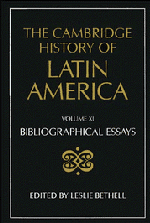Book contents
- Frontmatter
- I THE INDIGENOUS PEOPLES OF MIDDLE AND SOUTH AMERICA ON THE EVE OF THE CONQUEST
- 1 Mesoamerica before 1519
- 2 The Caribbean and circum-Caribbean at the end of the fifteenth century
- 3 The Andes before 1532
- 4 Southern South America in the middle of the sixteenth century
- 5 Brazil in 1500
- II COLONIAL SPANISH AMERICA
- III COLONIAL BRAZIL
- IV THE INDEPENDENCE OF LATIN AMERICA
- V LATIN AMERICA: ECONOMY, SOCIETY, POLITICS, c. 1820 TO c. 1870
- VI LATIN AMERICA: ECONOMY, SOCIETY, POLITICS, c. 1870 to 1930
- VII LATIN AMERICA: ECONOMY, SOCIETY, POLITICS, 1930 to c. 1990
- VIII IDEAS IN LATIN AMERICA SINCE INDEPENDENCE
- IX LATIN AMERICAN CULTURE SINCE INDEPENDENCE
- X THE INTERNATIONAL RELATIONS OF LATIN AMERICA SINCE INDEPENDENCE
- THE CAMBRIDGE HISTORY OF LATIN AMERICA
3 - The Andes before 1532
from I - THE INDIGENOUS PEOPLES OF MIDDLE AND SOUTH AMERICA ON THE EVE OF THE CONQUEST
Published online by Cambridge University Press: 28 March 2008
- Frontmatter
- I THE INDIGENOUS PEOPLES OF MIDDLE AND SOUTH AMERICA ON THE EVE OF THE CONQUEST
- 1 Mesoamerica before 1519
- 2 The Caribbean and circum-Caribbean at the end of the fifteenth century
- 3 The Andes before 1532
- 4 Southern South America in the middle of the sixteenth century
- 5 Brazil in 1500
- II COLONIAL SPANISH AMERICA
- III COLONIAL BRAZIL
- IV THE INDEPENDENCE OF LATIN AMERICA
- V LATIN AMERICA: ECONOMY, SOCIETY, POLITICS, c. 1820 TO c. 1870
- VI LATIN AMERICA: ECONOMY, SOCIETY, POLITICS, c. 1870 to 1930
- VII LATIN AMERICA: ECONOMY, SOCIETY, POLITICS, 1930 to c. 1990
- VIII IDEAS IN LATIN AMERICA SINCE INDEPENDENCE
- IX LATIN AMERICAN CULTURE SINCE INDEPENDENCE
- X THE INTERNATIONAL RELATIONS OF LATIN AMERICA SINCE INDEPENDENCE
- THE CAMBRIDGE HISTORY OF LATIN AMERICA
Summary
An early inventory of the sources for Andean ethnohistory is Phillip A. Means, Biblioteca Andina (1928), Transactions of the Connecticut Academy of Arts and Sciences, vol. 29, 271–525. It is still a useful discussion of the eyewitness accounts of the European invasion. More recent compilations by Peruvian historians are Rubén Vargas Ugarte, Manual de estudios Peruanistas, 5th ed. (Lima, 1959) and Raúl Porras Barrenechea, Los cronistas del Perú (Lima, 1986).
Beginning in 1956, the Biblioteca de Autores Españoles, published in Madrid by the Real Academia through its Ediciones Atlas, undertook new editions of many of the European chroniclers: for example, Bernabé Cobo’s Historia del Nuevo Mundo, (1653; Madrid, 1956). Each work has a new introduction, although they are of unequal value; the texts themselves are carefully reproduced. Two very early titles, whose existence was suspected but which had remained inaccessible, have finally surfaced: the missing second half of Juan de Betanzos’s account of events at the Inka court during the last years before Pizarro was located by María Martín Rubio in a private collection in the Balearics: Suma y narratión de los Incas (1551; Madrid, 1987); the Jesuit historian Carmelo Sáenz de Santa María reproduced the last missing part of Pedro Cieza de León’s Guerras civiles peruanas (1552; Madrid, 1985).
- Type
- Chapter
- Information
- The Cambridge History of Latin America , pp. 13 - 19Publisher: Cambridge University PressPrint publication year: 1995



